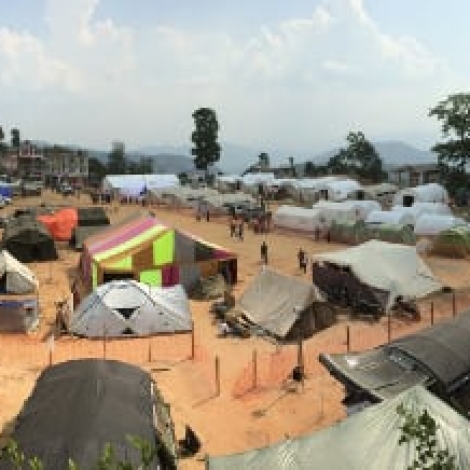Above is a panoramic view of the International Organization for Migration’s humanitarian base camp. The IOM set up its operations in Chautara, Sindhupalchok, Nepal, following its earthquake in May 2015.
Building toilets could offset the bleakest predictions of mortality from disease in the wake of Nepal’s earthquakes.
An estimated 8000 people have died since the first magnitude 7.8 quake struck April 25 in the mountains outside of the country’s capital Kathmandu. Dozens more are reported dead and missing after another 7.3-magnitude quake struck May 12 closer to the city.
Even as the country rebuilds, damage to toilets and other sanitation infrastructure will likely kill many more over time.
“The earthquake has caused unimaginable destruction,” Rownak Khan, UNICEF Deputy Representative in Nepal, said in a statement. “Hospitals are overflowing, water is scarce, bodies are still buried under the rubble and people are still sleeping in the open. This is a perfect breeding ground for diseases.”
The battle with cholera and other diseases of poor sanitation will be unwinnable, Antti Rautavaara, chief of water, sanitation and hygiene for Unicef in Nepal, told the New York Times.
More than 80 aid organizations and governments have responded. Lessons learned from past emergency sanitation interventions can prevent mistakes and speed the work. These resources may help.
Sanitation solutions for Nepal
E4C Webinar | WASH in Emergencies: Lessons Learned and Way Forward
Daniele Lantagne, a civil and environmental engineering professor at Tufts University in the United States and Sean Furey, a water and sanitation specialist at Skat Foundation in Switzerland present this webinar on emergency water, sanitation solutions and hygiene interventions.
The discussion covers the roles of WASH workers in emergencies, water quality tests and treatment techniques, best practices and the development of new methods and technology.
Construction guides, case studies and more
Find construction guides, case studies and other information on ecological sanitation latrines, composting latrines and more sanitation technologies in our Solutions Library.
We also have in-depth resources and discussion on sanitation and water technologies in our topical pages.
Here is a short list of other resources for water treatment and sanitation solutions.
- Ten low-cost ways to treat water. Treating water doesn’t have to be expensive.
- Research brief: The link between heavy rain, diarrhea and water treatment. Rain following drought may flush diarrhea-causing pathogens into the water supply. Treatment and sanitation my help. But only if they’re used.
- E4C Webinar | From technologies to lasting services. Learn about two tools that evaluate the viability of WASH technologies.
- USAID offers a recorded sanitation webinar.
And finally, this is our roundup of organizations that are seeking donations to continue their relief work in Nepal.

